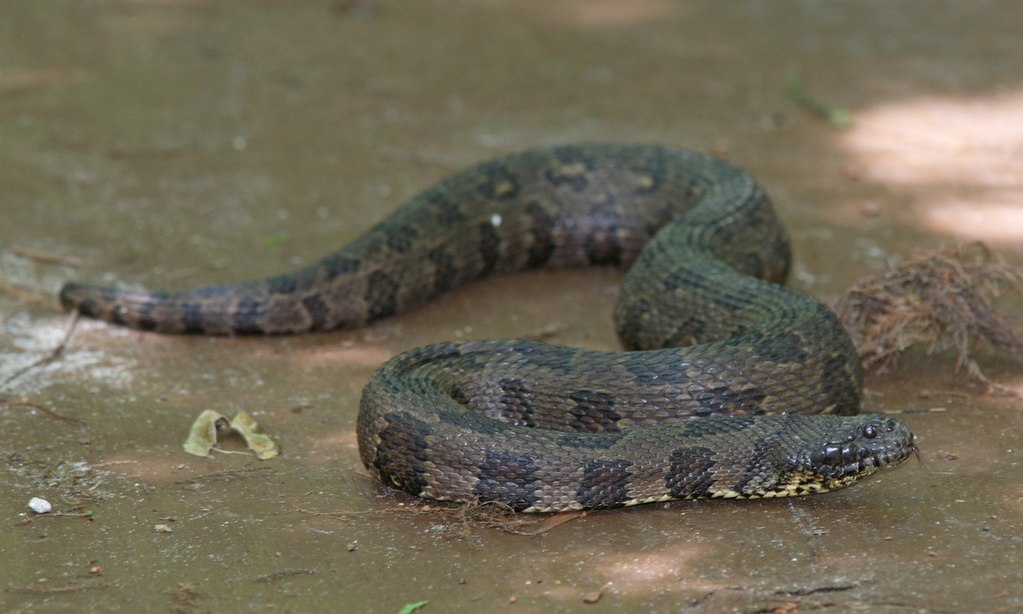
What’s that Snake in the Water?
December 15th, 2011
Written by Industry Expert, Shannon Junior, Aquatic Ecologist

Back in the days when I worked for a pond construction company, one of my crew members told me that he needed some help identifying a snake that they had found on the job site. He said it was a water snake, and thought it was a cottonmouth. I asked if he had taken pictures of it, but instead he presented me a burlap bag with the snake inside. Its head was smashed, and its body had been neatly cut into several pieces with the blade of a shovel. As an ecologist and lover of wildlife, the site of the demolished snake left me heartbroken and speechless. It was a large, beautiful and HARMLESS northern watersnake. All I could think of to say was, “That is NOT the way to identify a snake!”
This case of mistaken identity is not unusual. There are some very vague similarities in coloration and pattern between northern watersnakes (Nerodia siredon) and cottonmouths (Agkistrodon piscivores), and they also somewhat resemble copperheads (Agkistrodon contortrix). However, when seen side-by-side, the snakes do not actually look that similar. And unlike cottonmouths and copperheads, Northern watersnakes are non-venomous and harmless to humans if left alone. Unfortunately, though, misidentification results in more watersnakes being killed each year than venomous snakes.
Unless you live in the southeastern corner of Virginia near the Dismal Swamp or farther south, then it is unlikely that you will see a cottonmouth in the wild. They are not found in other parts of Virginia or anywhere farther north. These venomous semi-aquatic snakes are also known as “water moccasins”. When threatened or harassed, they will coil up and open their mouths wide to expose their fangs and the white interior of their mouths, which is why they were given the name “cottonmouth” – although hopefully you will not have the opportunity to witness this phenomenon up close! Again, though, they only exhibit this behavior when approached, and would much prefer to use their venom for hunting prey than for defending themselves against humans.
The other unfortunate look-alike for the northern watersnake is the copperhead. However, copperheads are terrestrial snakes, and prefer upland habitats such as rocky, forested areas to aquatic habitats. Their range is more widespread than that of the cottonmouth, and they are found throughout most of the eastern U.S. as far north as Massachusetts. Copperheads are responsible for many of the snakebites to humans reported each year, but they are rarely fatal. Most bites occur when people accidentally step on or touch the snakes because they are so well camouflaged with their surroundings. When disturbed, copperheads emit a musk that smells like cucumbers.
Northern watersnakes are not venomous or aggressive. They are beautiful! They are brownish-gray snakes with broad blotches and crossbands on their backs with varying degrees of red, yellow, and white. The juveniles are brightly colored, but the colors become more subdued as the snakes age. They are frequently seen basking on rocks or stumps near lakes, rivers and streams. They are active both during the day and at night, and eat small fish, amphibians, crustaceans, and even small mammals. They have been known to “herd” tadpoles with their body and eat them. They will flee from confrontation if given the chance, but may bite repeatedly if cornered. The bite will bleed a lot because of the anticoagulant saliva, but is not poisonous. Again, though, even a cute little chipmunk will bite a human to defend itself!
Watersnakes can be easily distinguished from cottonmouths and copperheads by the shape of their heads. The poisonous snakes have triangular shaped heads that are much wider than their “necks”, whereas the watersnake has a round head that’s narrower than its body. Cottonmouths and copperheads are pit vipers, and have discernable pits on top of their noses – though you might not want to get close enough to observe that characteristic! The venomous snakes also have yellow eyes with vertical slits for pupils, similar to cats’ eyes. Watersnakes have round eyes with round pupils. And when seen in the water, a cottonmouth swims with most of its back protruding from the water, while the watersnake swims with only its head visible.
If you are lucky enough to see a snake in or near the water, it is most likely a northern watersnake. The best thing to do is to quietly observe it from a distance if you’re interested, or walk the other way if you’re scared. It will not chase you or strike at you unless it feels threatened. And always remember, the best way to learn about wildlife is to arm yourself with knowledge, not the tip of a shovel!
FREE REPORT: 8 Questions to Ask When Hiring a Lake MGMT Company
Shannon Junior is an Aquatic Ecologist with SOLitude Lake Management. Since 1998, SOLitude Lake Management has been committed to providing full service lake and pond management services that improve water quality, preserve natural resources, and reduce our environmental footprint. Services are available throughout the Eastern United States. Fisheries management consulting and aquatic products are available nationwide. Learn more about SOLitude Lake Management and purchase products at www.solitudelakemanagement.com.









